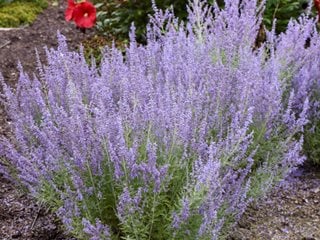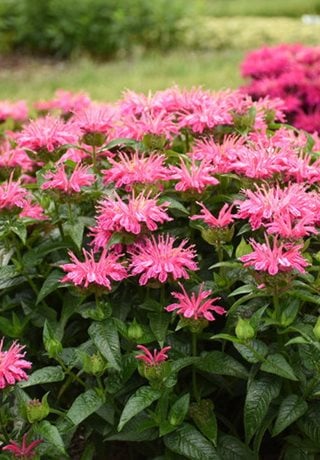Growing Russian Sage for Your Summer Garden
Newer cultivars with compact growth habits, sturdier stems, and longer bloom seasons make Russian sage plants more versatile than everIf you’re a lazy gardener like I am, you’re always on the lookout for plants that you can stick in the ground, ignore, and they will still look attractive for months on end. Russian sage is at the top of the list of those fuss-free garden perennials that you simply buy, plant, and enjoy. Just give them full sun and well-drained soil, then sit back and delight in their tranquil beauty.
This resilient plant has become a mainstay in the summer garden, both for its good looks and undemanding nature. Although it can be a slow starter in spring, it does make a statement with its silvery gray-green foliage and then really dazzles in midsummer when the stems are covered in lavender-blue flowers that often linger until fall.
If that's not enough to convince you that you need a Russian sage plant in your garden, it's also deer resistant, drought tolerant, and attracts bees, butterflies, and hummingbirds.
On this page: Basics | How To Plant | Care | Pictures | Design Tips | FAQs
BASICS
Botanical name:
Perovskia atriplicifolia
Zones:
4-9
Height/Spread:
2 to 4 feet tall & wide, depending on variety; newer cultivars grow in the 2-1/2-foot range
Exposure:
Full sun
Bloom Time:
Early summer to fall
Color and characteristics:
Lavender-blue to violet, two-lipped, tubular flowers bloom along 12- to l5-inch-long panicles. Although the individual flowers are tiny, they are abundant and closely spaced, intensifying their overall impact. The brightly colored calyxes remain, making the plant appear to be in bloom well after it has finished flowering.
Toxicity:
The leaves are toxic if ingested.
HOW TO PLANT
When to plant:
Container-grown plants are best planted in late spring once the soil warms up, which will encourage faster growth. You can also plant them later in the summer as long as you get them in the ground six weeks before a hard frost. If you are growing a Russian sage plant from seed, start indoors in early spring and transplant the seedlings outdoors after the danger of frost has passed.
Where to plant:
A sunny spot in well-drained soil is all this plant asks for, making it ideal for hot, dry climates. It also tolerates alkaline conditions and is a good choice for seaside gardens. Avoid planting in shade or overly fertile soil, which can make it floppy and inhibit blooming.
What to plant:
Container-grown and bare-root plants are widely available at nurseries and garden centers because they are easy to plant and will bloom the first season. Although some varieties can be grown from seed, they are harder to find and can take a long time to germinate. Unless you have a lot of patience, look for cultivars that will bloom the first year when grown from seed, such as ‘Blue Steel’.
Spacing:
Newly planted specimens take a year or two to become established but form substantial clumps over time, so space plants at least 2 feet apart.
RUSSIAN SAGE CARE
Water:
Water regularly during the first growing season to establish a deep root system. After plants become established, they tolerate drought without complaint and rarely need supplemental watering. The plant's vigorous root system helps it withstand scorching-hot summers and dry spells.
Pruning:
Cut the woody plant stems down to about 6 inches in early spring to make way for new growth. You can also do a light pruning in early summer if you want to reduce the height and make plants look fuller. For winter interest, leave the seedheads and silvery stems in place until spring.
Fertilizer:
Don’t bother. Russian sage will perform just fine without it. At most, apply a light layer of compost in the spring.
Staking:
Although the foliage of taller varieties can be a bit lanky, staking can be avoided by locating your plants where the foliage can flop gracefully or near other perennials that provide support. Newer cultivars, like 'Denim 'n' Lace', are more compact and don't require staking.
Dividing:
Unlike other mint family plants, the roots of Russian sage do not spread rampantly, so division is rarely required. It can also be difficult because of the plant’s woody base.
Winter care:
Rarely daunted by harsh winters; but in colder zones, cover plants with a layer of mulch for extra protection.
Diseases and pests:
This naturally aromatic plant repels insects, and diseases are practically unheard of. The biggest problem is root rot, which can be caused by poor drainage and prolonged exposure to wet soil.
RUSSIAN SAGE PICTURES
DESIGN TIPS
Garden uses:
- With its open, airy nature, Russian sage is an excellent filler, enhancing whatever it’s planted with and providing cool contrast to boldly colored plants.
- Plant it in mass to amplify the purple pyrotechnics.
- Compact and dwarf varieties, like ‘Little Spire’ and ‘Lacey Blue’, work well as informal hedging plants, for edging pathways, and in containers.
- Use taller plants in the middle or back of the border to add textural contrast and vertical interest.
- Because Russian sage thrives in dry conditions, it’s also a great addition to water-wise gardens.
- Also a suitable substitute for lavender, since they are very similar.
Companion plants:
- Yellow or orange daylilies
- Garden phlox
- Ornamental grasses
- Red or pink bee balms
- Yarrow
- Purple or orange coneflowers
- Black-eyed Susans
- Asters
- Butterfly bush
FREQUENTLY ASKED QUESTIONS
Is Russian sage edible?
Although the leaves may smell like those of culinary garden sage (Salvia officinalis), Russian sage is technically not a sage. The aromatic leaves emit a light herbal scent when crushed, and as noted above, are toxic if consumed. However, they can be dried and used in potpourris.
Is it Russian?
Not really. Despite the common name, it is native to western China, Afghanistan, and Tibet. The Russian connection is to the genus name Perovskia, which honors l9th-century Russian general V.A. Perovsky.
Related:
How to Grow and Design with Perennial Plants and Flowers
Deer-Resistant Plants for Your Garden
20 Full-Sun Perennial Plants
Color in the Garden










